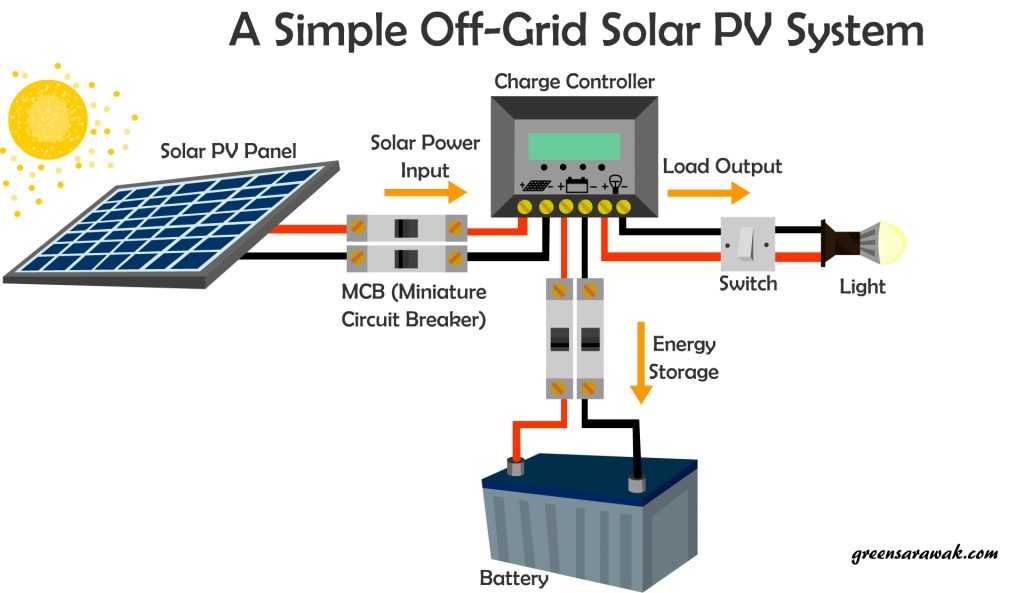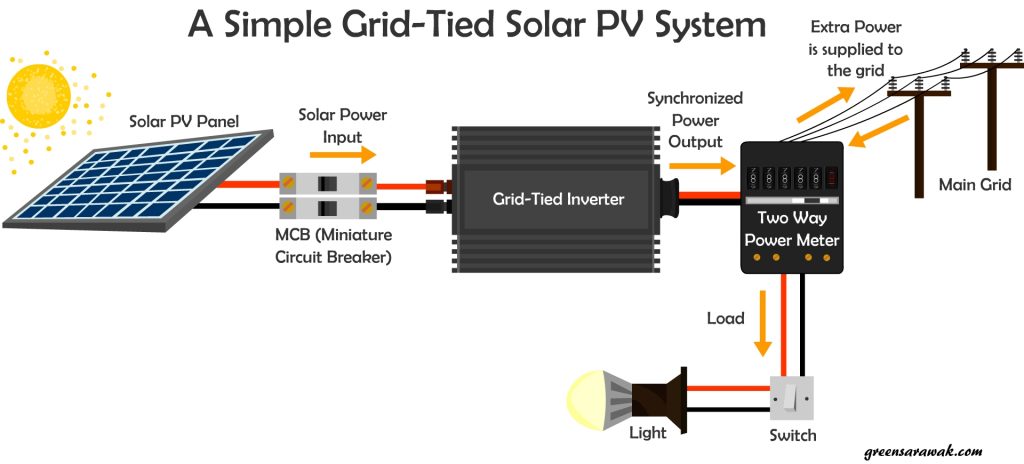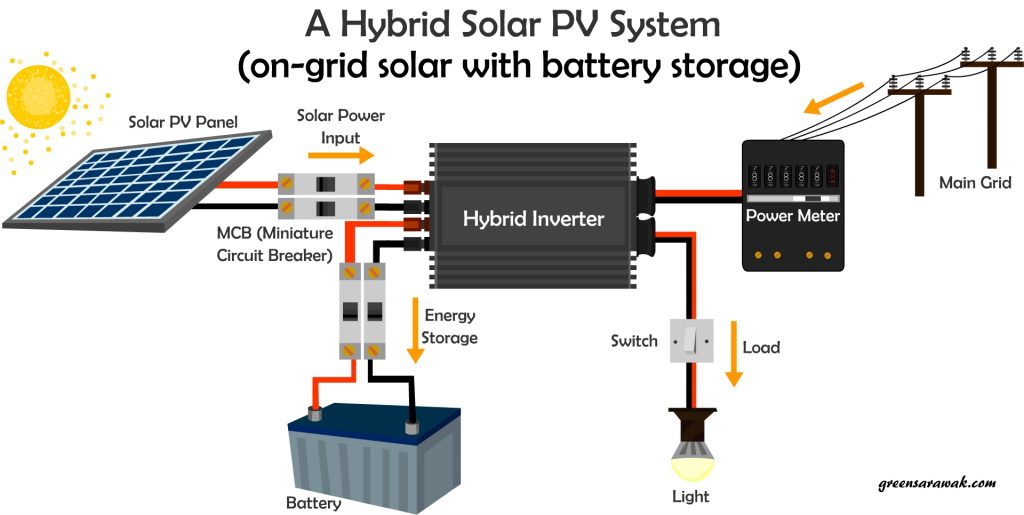A group of solar cells forms a solar module. A group of solar PV panels with other accessories forms a Solar PV System. Basically a Solar PV System will make sense to your power generation setup to supply you the electricity that you need most.
The basic Solar PV System can be divided into Off-Grid, Grid-Tied or Hybrid System. All of the three system have different benefits depends on the location and power utilization setting.
Off-Grid Solar PV System
An Off-Grid Solar PV System is one of the common system for those who would like to be power devices off the main grid or those who need portability and stay away from a grid.
The Pros includes:
- Simple and easy to build and maintain. It is as simple as A solar PV panel, Wires, A charge controller and a battery.
- Portability. You can power up your devices anywhere as long as there is sunlight. It is useful when going for camping in the Forest and on a RV trip on the great desert.
- No long wiring required to devices that is located far away from your nearest power grid. Wiring is troublesome across a large area and require experience installers and follow the local codes on laying overhead or underground wires to prevents electrical accidents.
- Fully customizable and scalable. You can have a small solar PV system that power your small appliances or huge solar PV system that power your whole house or neighborhood.
- Solar independence and energy self-sufficient. Since you don’t depend on your power grid for power supply, you don’t need to worry about power outages and pay any money to the utility grid. Some will also envy your bright lighted house when everyone’s power grid is down in the neighborhood.
- It is Green Sustainable energy which you can be confident of. The sun is free and you own all the energy it harvested. You no need to worry about the environment footprint from the power utility company as some of them are still dependent on polluting fossil fuel.
- Battery affordability in a foreseeable future. With advancement of technology and increasing in production of electric vehicles, in near future we will see a further drop in battery cost and increasing in battery efficiency.
What are the cons of a off-grid solar PV system ?
- Is all on your own. Without proper planning on the battery storage system and adequate solar PV panels to generate all the juice you need, you will end up a empty battery in the middle of the night where you need the power most.
- The battery cost is high basically due one main issue – they don’t last forever and you need to oversized them more than what you will consumed. If you frequently discharge them more than recommended ratting, you might end up spoiling your battery faster than you think. More on depth of discharge recommendation is in the next few section on “know your battery”.
- Most useful for smaller appliances and lighting where you don’t need to draw too much power. For example street lights, garden lamps, aquarium pumps, CCTV and your calculator. Larger power usage like rural telecommunication tower will need bigger solar PV array. It is possible to run Microwaves Ovens, Air Conditioner, Refrigerator and Water Heater with a Solar PV panels, but often not cost effective in comparable to Utility Grid and Backup Fossil Fuel Generators. Issues often arise when the power drawn from the system is greater than that is stored in the system, without a secondary support, the system will come to a complete halt.

Grid-Tied Solar PV System
The next type of Solar PV system is Grid-Tied Solar PV System. It is also known as on-grid, utility-interactive, grid inter-tie and grid back feeding. Basically it means it is a solar PV system that is connected to the utility power grid.
Grid-Tied system is most commonly found on homes which have already have a utility power grid but also wants to have add on benefit from self power generation from the self owned Solar PV System.
The benefits of the Grid-Tied Solar PV System is:
- You can use the power generated from the panels directly from a home plug. In a Grid-Tied system, the Solar PV is connected directly to the home power grid through a grid tie inverter. In a Grid-Tied system, the grid-tied inverters will detect the power and waveform from the main grid and then inject in a slightly higher voltage (e.g. 0.5 Volts higher) into the home power grid which is well synchronized to the home grid power phases (also known as synchronized inverters). If you have your electrical appliance switch on and requiring power, it will draw the power from the grid-tied inverters first before drawing extra energy from the utility power grid. It don’t save your electricity usage of your devices but able cut down the power drawn from the utility grid and hence reduce your monthly electricity bills.
- Net Metering. In some cases it makes you earn from your solar PV system. Extra juices in the home grid is injected to the utility grid, which will in turn reverse the home power meter (the meters turning backwards). Some states offers feed-in tariffs that allows you get paid for every kWh of power given to the grid. Other incentives are also available for supporting renewable energy.
- Lower cost of equipment and installation cost (fewer upfront cost). The major bulk of cost for a off grid solar PV system comes from its battery storage system that is purposely oversized to ensure continuous supply the power in needs or during prolong winter where sun hours is reduced.
- The whole utility grid is a virtual battery itself. You no need to worry about the home battery storage. Since battery maintenance is not cheap. Extra juices is push back to the grid without wasting unused energy (in a off-grid solar system, once the battery is fully charged and no load is using the power, all excessive power generated is wasted). Furthermore if you need more energy than what your solar PV system can supply, it can get help from the utility grid, without overloading your solar PV system.
- Grid-Tied inverters nowadays are highly efficient, especially those with integrated Maximum Power Point Tracking. Using a cheaper lead acid battery can lower your efficiency of your system down to 80%, further efficiency drop over time when the battery system is not well maintained or pass its service cycles .
- You don’t worry about overloading your solar PV system in a Grid Tie System. You can have power hungry devices running even it exist the capacity of your solar PV system can produce. It is all back to the sharing nature of the power load, the Grid-Tied Inverters supply the initial power, while extra power is coming from the power utility grid. Make sure that the total power rating of the solar PV panels and the grid-tied inverter is matched to prevent overheating of the inverters. You don’t push 1.5kW solar PV panel array output into a grid-tied inverter of 1kW.
With so much of benefits from a Grid-Tied Solar PV System, so whats is the cons ?
- Grid-Tied System is not a power backup solution. You cannot use the power generated from the solar PV system if you encounter a power outage from the main utility grid. It is mainly due to safety reasons. During a utility grid power outages, there might be worker repairing the main power grid outside, forcefully pushing electricity back to the grid will leads to unwanted electrical accidents to the repairing workers. The system will work again once the utility grid is back on.
- Be aware of the local laws regarding grid-tied inverters. Some places do not want you to attempt to reverse the electric meters, while other places may not offer extra income or incentives for giving power back to the grid. Consult a local authority or local seller of Solar PV system for any inquiry arise.

Hybrid solar PV systems
Off-grid and Grid-tied system have both its pros and cons. However newer Hybrid solar systems combines the best from grid-tied and off-grid solar systems. These systems can either be described as off-grid solar with utility backup power (Hybrid off Grid – HOG) Inverters, or grid-tied solar with extra battery storage.
They are called a smart power system. These system is quite expensive nowadays but will be seeing a drop in retail price of the hybrid systems.
Hybrid system is fully automated via a computerized system, that can decide when to use power from the solar PV panel, power from the battery or power from the utility grid. It reduces the dependency on the power utility grid and channel most of the power usage from the solar PV panels, and at the same time will ensure the battery being backup for usage during power utility grid downtime. It can further being setup to supply critical loads only with the power from the battery when the power utility grid is down.
Hybrid battery storage like Tesla Powerwall will allow you to program to store the power generated from the solar PV system in the day and power the house for the night. It is not meant to store days and days of electricity but will eventually reduce the utility grid peak power usage.
It is known that there is two major peak in power usage. The morning and the evening peak hours. In the morning 5am to 7am (up to 9am), it is a common scenario of morning ramping as starting up cold devices will require more energy, which includes starting of factory machines and office air conditions. In the evening 5pm to 7pm (5.30pm-7.30pm) will be the second peak where everyone going home and strat up their house lighting, air conditions and electric cooking devices. Hybrid battery can charge during non-peak hours (including from solar PV system) and supply back to the home during peak hours. These reduce the peak load on the national grid, and save some pennies (some states have different more expensive charges on power usage on peak hours).
Hybrid system is also scale-able. Since it can support very high power input and output (e.g. 10KW), it is suitable for general home usage with high power hungry devices like air condition and refrigerator. Adding specially manufactured battery packs will allow more energy storage depends on demands.
There is not much cons for a hybrid system other than the higher upfront cost.

NEXT CHAPTER >> Know Your Load
